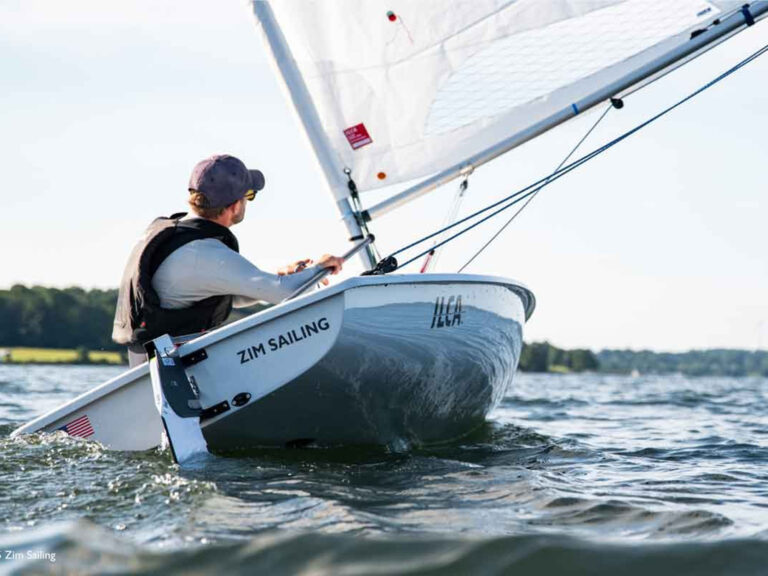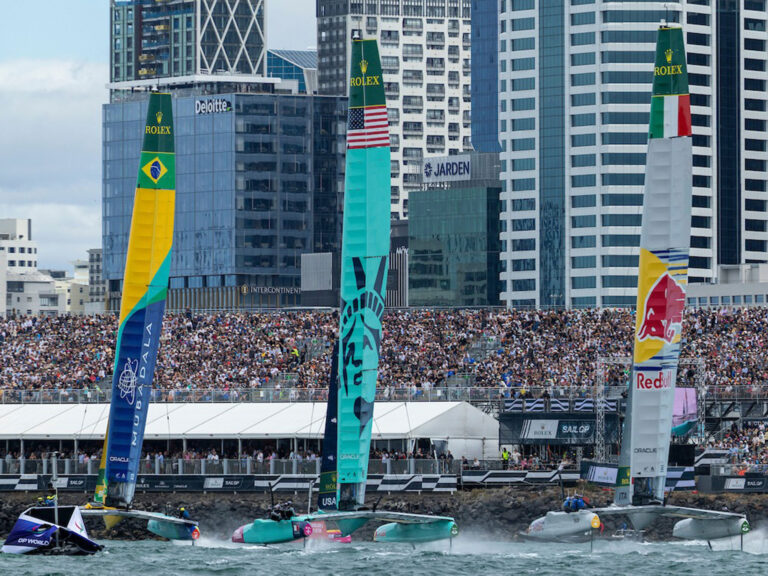
FBGOCSt
There is no shortage of big money racing events vying for the public’s interest. From the America’s Cup, which is gathering steam in Valencia, to the Velux 5 Oceans, which limped unnoticed into Norfolk, Va., last month, to the World Sailing League, Volvo Ocean Race, Barcelona World Race, and Vendee Globe, the number of events grubbing for a slice of attention pie is encroaching on the ridiculous. For this reason, I was a little cynical about the Portimao Global Ocean Race, a new distance race scheduled to begin in Portimao, Portugal, in September 2008. Speaking with the race’s communications director, Brian Hancock, was an effective cure cure for my pessimism. Hancock seems to understand the shortcomings of other ocean races, and he has positioned the Portimao Global Ocean Race to meet these challenges head on. “The idea behind the Global Ocean Race came about after we saw what a cock-up the Velux 5 Oceans had become,” said Hancock. “One of the reasons they’ve had such a hard time attracting entries is because it’s very expensive to race these 50- to 60-footers, and they’re very technically difficult, so it ends up excluding everyone except professional sailors with big time sponsors.”Back when it was Around Alone, it had more of an amateur feel,” continued Hancock. “People would bring their wife and kids to the stopovers, and there was time for the competitors to really relax and get ready for the next leg. That atmosphere is gone with the Velux, and we want to bring it back.”Hancock, a Whitbread Race veteran, and Josh Hall, a Vendee Globe veteran, designed the Portimao Global Ocean Race as a reasonably affordable stepping stone to more expensive, intense races like the Barcelona World Race. Hancock estimates the minimum budget for a team to be about $500,000, and because the race can be sailed solo, doublehanded, or with a rotation of up to four sailors, teams can split the campaign costs accordingly. The 2008 race will consist of five legs, with stops in Cape Town, South Africa; Wellington, New Zealand; Ilhabelha, Brazil; and Charleston, South Carolina.Why start another distance race?We saw there was a pent-up demand for doublehanded races, and we figured if we did it in 40s and 50s, it would more affordable, but the boats would still be cool to sail. And if we could keep the costs down, we figured there are plenty of people looking to take a once-in-a-lifetime adventure. For others, it can be a first step towards taking on races like the Barcelona World Race. When we first announced the race a year ago, we had 140 people contact us saying they were interested in registering. Now of course there’s a long way between first contact and the start line.What do you think it will take for a race to become popular with non-sailors?That’s a good question, and I’m not sure I know the answer to it, to be honest. These days we have all this new media, from instant video to web cams. The whole offshore sailing industry is becoming much more accessible to more people in real time, as opposed to doing documentaries afterwards, as they did in the past. In our case, having doublehanded crews makes it more of a human interest story than just a sailing story. We have a father-daughter team, a black and white team from South Africa. We’ll do the traditional TV documentaries for Discovery Channel and the BBC, but we’re also having competitors send in podcasts and video clips to iTunes and YouTube. That way it will be easier for non sailors to follow-it’s easy, it’s free, and hopefully people will go, “Hey, look at these guys cruising their [butts] off on big waves! I wonder what happened this morning?” We also have a huge educational program we’ll be running in schools where we’ll use the race to teach different subjects. Hopefully this is a way to get kids from non-sailing families interested in the offshore ocean racing dynamic. How does the Portimao Global Ocean Race compare to other ocean racing formats?The Cayard idea [The World Sailing League], from what I’ve heard, is not getting much traction, but their concept is superb. I hope it takes off-it’s the right idea at the right time. I think the Volvo is on the way out. Their new course format seems a little off, and the budget is so high with crews asking so much. It takes a ton of crew to sail those boats, and because the boat is so complicated and dangerous, the crews deserve to get that kind of money. On the other hand with the Vendee Glove there are no stopovers, so you don’t need a shore crew. And the Barcelona World Race is going to continue to get more boats because there’s more of a demand for doublehanded races. I’d love for the Global Ocean Race to spawn a new generation of Vendee Globe sailors who go on to the Barcelona Race. Soon, there’s going to be room for a lot of up and coming sailors. This is the last hurrah for a lot of the veteran ocean racers, and there’s a lot of sailors in the Minis Transats and the Figaros who are looking to move in. What have you done to make this race affordable?First off, the whole intent of this race is to make it an event for the competitors. One mistake other races have made is they charge this huge entry fee. We’re charging a $10,000 entry fee, but we’re giving back $2,000 at the end of each leg. We figured it wouldn’t be fair to charge this huge entry fee and then ask them to email videos on top of that!For the doublehanded division, teams can have up to four people. The thinking is, for $100,000 a piece, four people can buy a Class 40. The first two race the first leg, the other two race the second leg. That way, teams can race without having huge sponsorships. We’d like to get teams from many different countries involved, so that there’d be four people from Brazil, four from Germany, etc.We figure that for $500,000 dollars, a team can build a Class 40 and campaign it around world. It’s not cheap, but it’s not the multimillion dollar commitment some of these other races require. Do you forsee this as a spectator event?On each leg there’s a point gate that the boats have to pass through. For instance, there’s one gate off the Brazilian coast where people can come out and watch. We’ll have film crews to rendezvous with each boat at the checkpoints. How is the entry field shaping up? As far as big names, none of them are huge names, but we’ve got Joe Harris, who has done the Route du Rhum and a number of Transats, Richard Tolkien, a British guy who has done the Vendee Globe, and there’s a guy Rodger Martin, who is designing a boat over in Bristol [R.I.]. This is not a race for amateurs, in the true sense of the word. We have a strict qualifying sail they have to do before we’ll let them go.Of the teams so far, we’re seeing about three-quarters doublehanded and one-quarter singlehanded. We’re expecting about 20 to 25 boats on the line, but it’s a double-edged sword. The more competitors we have, the more the race is going to cost in terms of logistics. And since we’re not charging huge entry fees, we’re hoping it doesn’t get so big we can’t afford it. How did you decide on Portugal?Well we weren’t going to start on the East Coast [of the United States], and we weren’t going to start in England. We wanted to start someplace easy, and Portimao is great. Once you’re cleared the starting line, you go 20 minutes and you’ve hit the trade winds.We’ll also have stops in Cape Town [South Africa], Wellington [New Zealand], and Ilhabelha, Brazil, which is a safe seaside community good for families as opposed to Salvador or Sao Paulo. It’s a place where the crew can decompress before going up to to Charleston [South Carolina], where Brad Van Liew will be managing the stop. From there, they go back to finish in Portimao.
For more about the Portimao Global Ocean Race, click here.





